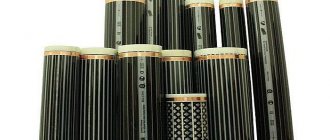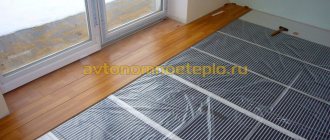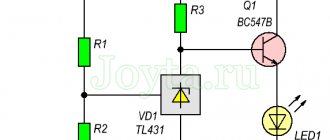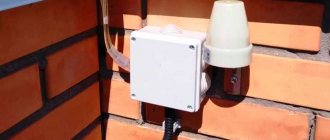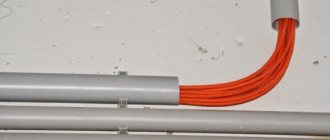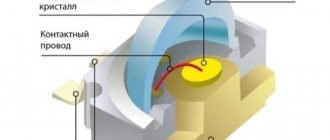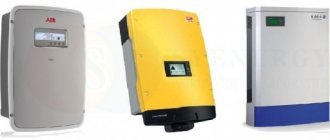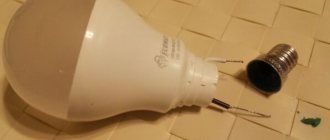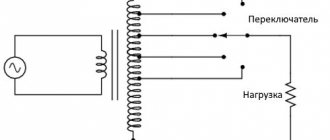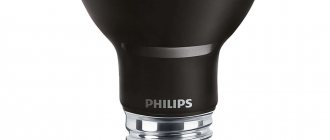SHARE ON SOCIAL NETWORKS
FacebookTwitterOkGoogle+PinterestVk
Previously, installing infrared flooring was considered a luxury, however, today this method of heating rooms has gained wide popularity. Infrared film heated floors are a modern and practical option for organizing primary or additional heating in a room. In this article we will look at the benefits of installing infrared film, its types and compatibility with floor coverings.
Thanks to infrared film heaters, an economical and efficient underfloor heating system can be built in a matter of hours
Infrared heated floor: pros and cons
Heating using IR film has many advantages over other types of similar heating. Let's consider the main advantages of this heating design:
- such a system cannot fail at the same time, since it is connected in parallel;
- possibility of installation on any type of surface - both horizontal and vertical, as well as on elements that are located at an angle;
The film does not contain components hazardous to human health, does not produce unpleasant odors or toxic fumes
- The design features of the infrared floor make it possible to achieve uniform heating of the room. This is especially important if laminate is used as a floor covering;
- another advantage of such a system is ease of installation;
- possibility of disassembly if necessary;
- this film is suitable for installation in rooms where the humidity level exceeds the permissible parameters;
- compatibility with different flooring options;
- installation of such a system is allowed not only in enclosed spaces, but also in open conditions (for example, on a veranda);
- high heat transfer coefficient, which reaches 97%;
- The efficiency of film infrared flooring is approximately 30% higher than that of other underfloor heating systems. The prices of film heated floors fully correspond to their effectiveness.
Note! When choosing IR film for organizing floor heating, you need to take into account one very important parameter - the height of the ceilings. The lower the ceiling height, the more efficient the heating of the room.
However, this design also has some disadvantages, among which are the following:
- the need to follow clear rules when connecting;
Unlike other heating systems, infrared floors act directly on the surfaces of heated objects and do not dry out the air in the room at all
- high inertia, due to which heating and cooling occur very quickly;
- poor resistance to mechanical stress in comparison with a tubular structure that uses water as a coolant.
The film system is generally not suitable for installation as the main heating system. It is recommended to use an infrared design for additional heating.
Demand for infrared floors for apartments
First of all, everyone notes the main advantage - the ease of installation of such a coating. Installation is not very difficult, so many owners cope with it themselves or hire one specialist. Efforts like in a major overhaul, a team of workers, and a long period of time are not required.
For example, you can improve the climate in one room. Often this is a children's room. It is enough to carefully remove the floor covering, install the infrared heating system, and then simply fix the same finishing layer.
You can often find advertising articles and reviews in which managers cite the healing properties of an infrared ray as the main advantage: it disinfects the air and destroys germs. But this factor can hardly be called the main one, and such advertising does not inspire much confidence among consumers. It is difficult to give examples to make this effect of heated floors obvious.
Important point! Infrared coatings can be used as heated floors on steps and porches. The system copes excellently with ice, and it is not afraid of frosts and temperature fluctuations.
Types of infrared films
From a design point of view, all IR films are similar and have a common operating principle. However, for various types of premises and operating conditions, it is customary to use certain options for film heated floors. The differences between ICs are primarily due to the fact that they are produced by different companies.
Let's consider the types of IR film based on maximum heating temperature and their compatibility with various floor coverings:
- high-temperature infrared heated floors under tiles. The maximum heating temperature of such systems reaches 50°C. They are incompatible with floor coverings that are more susceptible to heat (linoleum, laminate);
In their structure and principle of operation, all infrared films are similar to each other, the main difference is the maximum heating temperature
- low-temperature infrared heated floors for linoleum and laminate. Such systems can heat up to 27°C;
- universal IR systems that are compatible with all types of floor coverings.
The second parameter by which IR films are classified is the type of heating element. Today, there are two main types of infrared floors, depending on the heating element:
- carbon;
- bimetallic.
The power density of the infrared floor is the last indicator, which is very important when choosing heating. Let's consider three main types of IR films, depending on this parameter:
- with low power (130–160 W/m²) - used in cases where it is necessary to organize heating of a room with a small area. Compatible with “light” floor coverings;
Infrared films from different manufacturers may differ in appearance and technical parameters
- with average power (from 170 to 220 W/m²) - installed in more spacious rooms. Perfect for the following flooring options: porcelain stoneware, tiles;
- with high power (above 220 W/m²) – installed in industrial buildings. They are also used for floor heating in saunas and various workshops.
If necessary, you can always contact specialists who will help you choose the necessary system for a particular case. It is also recommended that before purchasing, read the relevant reviews on specialized forums. Film heated floors are an innovative solution for any room, allowing you to achieve maximum comfort.
Features of carbon and bimetallic IR films
Carbon films used for underfloor heating are more expensive. The heating elements in such a system are made of a special carbon material, which has a fibrous structure. In some cases, they are equipped with a protective layer of graphite. Spraying of this material helps to increase the strength characteristics of the system and also affects the length of its service life.
The basis of the material is represented by lavsan film. Carbon infrared film flooring can be mounted on horizontal and vertical surfaces.
Scheme of bimetallic infrared film for heating
Helpful information! When installing carbon film for a heated floor, the choice of connection diagram is very important. In such a situation, experts recommend using a parallel connection option.
Bimetallic IR film differs from carbon film in that it has heating elements consisting of two metal layers (aluminum and copper). The material is based on double polyurethane film, which has good elasticity.
The installation of a bimetallic system is complicated by the fact that a ground electrode cannot be connected to the system. Also, the bimetallic structure is incompatible with ceramic flooring. It belongs to the low-temperature variety, so its recommended heating level does not exceed 27°C.
Advantages
Let us outline several advantages of infrared heated floors. Experts note: radiation is completely safe for health. It is capable of destroying bacteria in the room and heating the air quickly and evenly. The surface of the canvas consists of special strips, and the radiation is provided by power from electricity.
Important! The effectiveness of infrared floors is cited as a significant advantage. They guarantee comfort and a stable indoor microclimate. You can heat large floors, as well as local areas in the room. At the same time, the heat is felt as natural, which is created when heated by the sun.
Let us dwell on several advantages of infrared heated floors, which are most often noted by users and experts in their reviews.
- The film coating has a minimum thickness. In this way, it is possible to maintain the original height of the room. It is important that you don’t have to arrange a screed.
- Installation is quite simple and fast. The base surface does not require careful preparation. It is allowed to install heated floors when all major work has already been completed.
- According to the manufacturers, there are no problems with dismantling work either. When the need arises, you can remove it and lay it in another room, and also take it with you when moving for subsequent installation in a new place.
- Environmental safety plays a huge role. Infrared flooring can be installed in children's rooms. It does not emit harmful substances and does not cause reactions even in people with hypersensitivity. Moreover, radiation even brings real benefits, as it allows you to destroy bacteria and disinfect the air in the room.
- Heating is carried out evenly over the entire surface of the floor. As a result, an optimal microclimate is created in the room, comfortable for living and relaxing.
- It takes minimal time to warm up. After switching on, it will take just a few minutes.
It is important! Versatility has also become the main advantage of infrared warm floors. It is installed in premises for various purposes: in greenhouses and garages, in offices and cottages, in apartments and shopping complexes. It is permissible to use such systems under heavy loads on the floor covering, for example, in sports centers.
Interestingly, film heated floors are mounted on almost any surface, for example, on walls.
Almost any material can successfully act as a decorative finishing coating. There are no difficulties with laying laminate or linoleum.
Difficult moments, specifics
We should also dwell on some negative factors and consider the so-called pitfalls of such systems. Here are the key disadvantages:
- When the installation is carried out incorrectly, the installation and operation technology is violated, this can cause a fire in the heated floor.
- Difficulties in the functioning of the thermostat. The element is necessary to regulate the heat supply: using special sensors, the device determines when to start and stop the heat supply. But an emergency power outage or a drop in the network provokes malfunctions and breakdowns of thermostats. It is better to choose models with an independent power source.
- The floor cools down too quickly. During power outages, this factor becomes a serious problem. A good solution is to lay a heat-insulating layer between the base subfloor and the heating elements. This will keep you warm for a long time.
- Under flexible linoleum, the heated floor film is more susceptible to any mechanical stress and fails faster. A thicker layer should be placed between the topcoat and the infrared system. You can lay the linoleum itself in two layers.
- It must be remembered that the coating is still vulnerable. It is subject to mechanical damage, which must be taken into account during the installation process.
- The budget also needs to be calculated in advance. High-quality heated floors are currently quite expensive.
There are several useful recommendations: with them you can remove some risk factors and minimize the likelihood of damage to the warm coating.
Expert opinion
Yakovlev Alexey Sergeevich
Electrician with 20 years of experience and extensive experience
It is known that the film can be used together with linoleum. It covers about 70% of the floor area. Ultimately, the floor surface becomes a good additional source of heat: it not only gives comfort when walking barefoot, but also allows you to warm up the room well in the off-season, when central heating is not yet functioning.
But here you have to take into account the key point: the finishing coating must be of high quality. Otherwise, it will gradually begin to deform and lose its original shade and geometry.
Important! Another serious factor is the pressure on the surface of the heated floor. It cannot be laid in areas where large-sized furniture is planned to be installed. This rule applies to any infrared coating systems. Thus, the film will overheat due to excessive mechanical stress and fail. This is due not only to mechanical stress, but also to an insufficient level of heat transfer.
Technical characteristics and operational scope of film flooring
Before purchasing IR film, it is imperative to study all its main technical characteristics. This knowledge will help you select the required type of system and calculate it for a specific room. Let's consider the characteristics of such heating structures:
- IR film is produced and sold in rolls, the length of which reaches up to 100 m. The width of the roll can be different (from 50 to 100 cm), and its weight is approximately 55 kg;
Rolls of IR film come in different widths - from 50 cm to 1 m, their thickness can be from several microns to several millimeters
- the finished structure is powered from the electrical network, the voltage of which is standard 220V;
- per day, the IR floor consumes approximately 20 to 70 W/m²;
- the speed of heating the film to the maximum temperature is quite high (about 2 minutes);
- surface temperature can reach 50°C.
If you decide to use such a film as the main heat source, then you need to remember that it must cover at least 70% of the floor area. In regions with cold climates, film electric heated floors can only be used as additional heating.
Film heated floors Caleo
Caleo has a wide range of infrared films for underfloor heating, making it easy to choose the right system for a specific situation. The products of this brand are represented by both simple options and ultra-modern film coatings, the operation of which is as automated as possible.
Today this company produces 4 main modifications of infrared film systems.
Caleo IR film is sold complete with an installation kit: contacts and bitumen insulation, some also include connecting wires
LINE. An inexpensive system that is perfect for installation in small spaces.
GRID. A product belonging to the middle price segment. A special feature of the GRID infrared floor is the presence of an anti-spark mesh, which is made of silver.
Note! Caleo warm floors have their own characteristics. For example, their installation should be done only using the “dry” method. They are also not suitable for installation under ceramic floor coverings.
GOLD. As in the previous case, anti-spark mesh technology is used here. And also such films can self-regulate, which allows reducing energy consumption by up to 20%.
PLATINUM. The most expensive option for infrared flooring. It is distinguished by energy-saving qualities that can reduce electrical energy consumption by 5-6 times. IR flooring PLATINUM can be installed under areas that are covered by furniture, without the danger of overheating.
All of the above models have a remote control function. Installation of Caleo heated floors is carried out without the necessary organization of screed or special adhesive coating.
Caleo infrared film can be used as a main and additional heating system in almost all types of premises
Infrared film floors from the Rexva brand
Rexva IR films occupy second position in the ranking of heated floors. This company produces ultra-thin film communications that can be installed on various types of surfaces (vertical, horizontal and even on the ceiling). The Rexva range of heated floors is represented not only by systems with a standard power range.
For heating residential and industrial premises, this company offers infrared films, the power of which reaches 400 W/m². As a rule, such models are used to organize heating in saunas. They are characterized by a high level of water resistance, as they have a special double-sided coating located on top of the main lamination.
Products from the Rexva brand are highly durable and resistant to high pressure. Their operational scope is quite wide - from small rooms to gyms. The price of the Rexva infrared floor fully corresponds to good quality and reliability.
New film floors from RexVa have appeared on the market with a self-regulating effect, that is, with local overheating, it changes its own heat transfer in this area
Features of IR films from Heat Plus
The Heat Plus brand produces heated floors (including infrared). The peculiarity of the models manufactured by this company is that they can have different film shapes, namely:
- striped;
- solid.
Related article:
Do-it-yourself water heated floor, video and description of the process
Description of the installation process of a water heated floor. Its advantages and disadvantages are different from other types.
Features of the IR floor production technology from this company make it possible to avoid the presence of unheated zones. The production of such film systems involves uniform application of carbon material on a polyester base, which allows achieving a high level of efficiency of heating communications.
Let's look at other advantages of Heat Plus IR floors:
- ease of installation;
- wear resistance;
Infrared film Heat Plus consists of safe and environmentally friendly materials and is a coating with a thickness of 0.338-2 mm, consisting of 5-9 technological layers
- reliability.
The service life of such products can reach 15 years under normal use. If desired, organizing such a system takes no more than one day, which is very convenient.
Note! The price of IR floor Heat Plus is several times higher than the standard one. However, products from this brand pay for themselves in 1-2 years.
Using a thermostat
To increase the efficiency of the heated floor and the ease of its use, as well as to save energy consumption, a thermostat (thermostat) is installed. This device allows you to control the heating system on and off, as well as record the temperature for a certain period of time.
When choosing a thermostat, you should pay attention to its power - it must correspond to the maximum power of your heated floor for the most correct operation. Read more about thermostats here.
You can find out more about calculating underfloor heating in this article.
Copying and using texts from the website of the “WARM FLOOR” chain of branded stores without indicating the source is PROHIBITED!
Warm floor infrared film Monocrystal
The Monocrystal company is located in Ukraine and is the only manufacturer of IR floors in the CIS. Thanks to South Korean technologies used in the manufacturing process of IR films, products from this brand have taken a confident position in the construction market.
The main difference between Monocrystal models is that they do not contain silver paste. To achieve the necessary electrical contact, products from the Ukrainian brand are equipped with a thicker layer of carbon paste. In this way, stabilization is achieved between the copper busbar and the heating device.
Let's look at the main technical characteristics of Monocrystal IR floors:
- film width – from 30 to 60 cm;
Special graphite film for tiles - produced by the Ukrainian company Monocrystal
- step – 20–25 cm;
- powered by an electrical network with standard voltage (220V);
- maximum power indicator – up to 200 W/m²;
- The maximum heating temperature of the material reaches 50°C.
The service life of IR film from the manufacturer Monocrystal is 10 years. The model range includes the following varieties: linear, perforated, solid. Perforation is arranged for compatibility with tile flooring. Film heated floors under tiles are widely popular among buyers.
Infrared heated floors: consumer reviews
Today, many home craftsmen refuse to install water-heated floors and give their preference to infrared floors. This is primarily due to the fact that a water system requires a longer installation time. And also its use is possible only after the screed has completely hardened. On many construction forums, consumers recommend infrared film heated floors. Reviews about these models are mostly positive.
The infrared energy emitted by carbon elements is completely identical to that emanating from the Sun, which is why it is so comfortable to be in a room with such heating
Consumers also pay attention to the efficiency that manifests itself in the process of using such heating systems. Studying various comments, you can see that many people point to savings in energy consumption with film heated floors. Reviews talk about saving electrical energy when using such systems by up to 20%.
Helpful information! Some IR systems take no more than 3 hours to install and can be used immediately after installation.
Such heating communications are considered completely safe and are repairable. If individual segments of the IR system are damaged, it does not fail completely. In addition, they can be easily replaced and continued operation of the system, which is often indicated in reviews. Warm floors under laminate are in great demand and usually cost the most.
Negative comments are much less common and, as a rule, indicate that when replacing the system, it becomes necessary to dismantle the floor covering. Most often, infrared heated floors are installed under laminate. Negative reviews in this case tell us that this floor covering cools down very quickly and the heating system cannot be used as the main one.
Laying and connecting film IR heaters does not require special training and can be done by hand
Tips for choosing ITP
Before purchasing a heated floor, you need to pay attention to the following points:
- Reliability of insulation. In the case of film ITP, it is advisable to try to delaminate the insulation yourself. If you can do this manually, the film is of poor quality. The same applies to rod heated floors. The rods should not fall out of the insulation due to simple force. In both cases, high-quality insulation can only be broken with a knife.
- Reliability of contacts. Does not apply to the core ITP, since all contacts there are insulated and invisible. In film IHP, you must try to “break” the contact by bending the film at the junction of the conductive and heating strips.
- Width of conductive and heating strips. The wider both elements are, the more reliable the system is and the better it heats the room.
- Appearance. There should be no debris under the film, even the smallest. The carbon strips must have the same shape, the same size and the same structure. In addition, there should be no damage on the surface of the film: dents, punctures, cuts, cracks, and so on. All this can break the tightness of the insulation.
When choosing, it is necessary to take into account the characteristics of each type of ITP. For example, it is not recommended to lay infrared film heated floors in a bathhouse, as they are susceptible to dampness. If the insulation leaks, dampness can lead to a short circuit.
Striped film flooring is not placed under massive furniture. This threatens to overheat the floor covering, which will lead to its damage. Either no ITP is installed under the furniture at all, or a carbon heated floor (film or rod) is installed.
In apartments (houses) with low ceiling heights, using a rod-based heated floor is simply irrational. It requires a screed of at least 2-3 centimeters, which will also reduce the distance between the floor and the ceiling. On the other hand, rod ITP can be laid on a slightly uneven surface, then it will be leveled using the same screed.
In a room where there are a lot of curves, bends, turns, and so on, it is better to take a carbon film floor that can be trimmed. You can also take carbon ITP, but part of the space, one way or another, will remain unfilled.
Drawing up a connection diagram for a film heated floor
In order to avoid installation errors and other surprises, experts advise choosing a connection diagram and drawing up a project plan before installing IR film. An elementary diagram will help not only to correctly calculate the amount of material needed in a particular case, but also to select the film required in terms of power.
Let's consider the points that need to be taken into account when drawing up a connection diagram:
- cutting of infrared fabric is carried out strictly in those places that were marked by the manufacturer;
- It is strictly forbidden to cut at any angles and try to form shaped elements from the canvas;
- installation of the film is carried out in parallel strips;
- the strips must be laid in such a way that they do not overlap each other;
- It is important to remember that the gap between the film sheet and the furniture should not be less than 3 cm. The same distance must be maintained between the edge of the infrared sheet and the wall;
- copper bars of adjacent panels should not touch. The minimum distance between them is 1 cm;
- the number of connection points should be kept to a minimum;
Connection diagram for infrared film heater
- the best option for locating the connection points is on the side of the wall on which the thermostat will be installed;
- the diagram must be drawn up in such a way that the main part of the wiring is hidden behind the baseboards;
- when using short film sections (up to 100 cm), it is necessary to take care of additional insulation and purchase additional terminal clamps.
Helpful information! The individual panels are joined together using adhesive tape.
The thermostat must be selected in advance, before installing the electric heated floor. Reviews about these devices can be easily studied on specialized forums on the Internet. If the area that needs to be heated is quite large, then you need to purchase additional temperature sensors.
Preparing the base for laying infrared film
After choosing a laying scheme and purchasing material, you can begin pre-installation preparatory work. A very important point is preparing the base for laying the infrared floor. If the old concrete screed is not even, then it must be dismantled. However, if everything is in order with the screed, it is enough to simply clean it of debris and remove dust.
To prevent heating towards neighbors living on the floor below, it is necessary to lay heat-reflecting material for infrared heated floors
In most cases, the base has many small cracks and chips before laying the film. Experts advise eliminating these defects using cement mortar or any other suitable composition. In some situations, owners discover that the screed has begun to peel off from the subfloor. This situation requires the removal of the old screed and the organization of a new one.
The joints that form from connecting the walls to the floor must be carefully leveled and sealed if they have cracks. If this is not done, then the film floor will lose heat through them.
After preparing the base, it is necessary to lay thermal insulation material on the screed. As a rule, a reflector made of foamed polyethylene is used for these purposes. The joints of the individual insulator sheets are glued with mounting tape, and this is where the process of preparation for installation of the infrared heated floor ends.
What is infrared heat
Infrared heated floors are a successful marketing technique that allows you to increase the number of sales through the use of an unusual word for many, which evokes associations of a direct connection with “big science.”
What is infrared heat
What is this really?
There are three options for transferring heat from a hot body to a cold one:
- Convection. Hot air rises, cold air falls down. The temperature in the room is equalized throughout the entire volume due to the constant movement of air. Warm air heats our body with the kinetic energy of molecules. The higher the temperature, the faster they move, the more force they hit our body and transfer their energy to it. Due to such processes, we also heat up;
- By conduction . This heating method requires direct contact, heat transfer occurs only at the point of contact. Conduction combines two physical methods of body transmission: due to the kinetic energy of rapidly moving electrons of a heated body and due to radiation in the infrared segment;
- Infrared rays. Most objects on the planet are heated using this method. The sun is the main and most powerful source of rays in the infrared spectrum. All objects with a temperature above absolute zero (-273°C) emit infrared thermal waves. The higher the heating, the greater the intensity of infrared (thermal) radiation.
Infrared radiation (thermal)
The sun emits several types of waves: gamma rays, x-rays, ultraviolet, visible, infrared rays and microwaves. We are only interested in infrared. The length of these rays ranges from 0.74 µm to 100 µm.
Infrared rays
For reference. The human body emits rays of the infrared spectrum from 6 microns to 20 microns. The length is directly dependent on the heating temperature of the body. We provide this information for those who are terrified of the word “infrared.” From a physical point of view, “infrared” can be called water heating radiators, stoves, fireplaces, etc. That is, all objects that emit heat. If their temperature is higher than body temperature, then they are infrared heaters in relation to us. If lower, then they are infrared “absorbers”, absorb our waves and heat up due to them.
Features of laying film heated floors under laminate
After completing the preparation process, you can proceed directly to installing the IR film. The installation algorithm for a heated film floor under a laminate is as follows:
- First of all, it is necessary to cut the material. The length of the strip should not be more than 8 m;
Before laying the infrared film under the laminate, it must be cut correctly
- At the second stage, the strips are laid. In order to reduce the number of joints, experts recommend laying sheets of infrared material along a long wall. The distance from the edge of the film to the wall should be at least 10 cm, and the distance between adjacent panels should be at least 5 cm. Installation of film heated floors is best done using the parallel method;
- Next you need to connect the wires and insulate unused contacts. The wires are connected using special clamps - terminals. And for insulation, a special bitumen tape is used, which has a high sealing coefficient;
- then the infrared floor wires are connected under the laminate. To do this, you need to connect the wire to the terminal and insulate it;
- At this stage, the temperature sensor(s) are installed. Experts advise placing these elements under the second canvas (closer to the midpoint). The sensor is installed in this way: it must be glued to the underside of the canvas on the black strip;
- Next, the infrared heated floors are connected to the thermoregulatory device. To do this, you need to connect the wires from the film and the temperature sensor to it. The connection itself is made through an RCD;
When installing IR film, you should use only special types of laminate that are designed specifically for such systems
- Next, you need to check how the installed communication functions. To do this, a trial run is carried out;
- The last stage of installing an infrared floor involves laying the appropriate floor covering on top of it, which in this case is represented by a laminate.
Helpful information! The wire belonging to the sensor can be placed in corrugated protection. This will simplify the repair procedure if necessary.
It is recommended to keep it in the room for 2-3 days before laying the laminate flooring. This is necessary so that it acquires the appropriate temperature, which will further prevent its expansion. To become familiar with the features of using IR film in this case, it is recommended to read reviews on specialized websites. Film heated floors under laminate are the most common today.
Installation
Is it difficult to install an infrared electric floor heating with your own hands? Let us divide the description of the work into several stages.
The video attached to the article will help you learn more about the rules for installing them.
Connecting film to wires
To attach the film heater section to the thermostat, you will need an installation kit containing:
- Studded contact terminals. The spikes pierce the current-carrying conductors, providing electrical contact between the IR film and the power wire;
- Twin-core copper wire with a cross-section of 1.5 mm2;
- 6 bitumen insulating strips.
The photo shows an installation kit for one heating section
Here are step-by-step instructions for connecting the heater to the wires:
- Bend the terminals and crimp them with special pliers or ordinary pliers on the current-carrying paths;
Installing a terminal on a live path
- Strip the ends of the power wires;
- Crimp the stripped ends with terminal sleeves;
- Stick bitumen insulators (two on each terminal and one on the sections of the current-carrying paths);
- Check the heating of the IR film by plugging the power cords into an outlet.
Attention: low-power (150-220 W/m2) film heats up slowly and to a low temperature. The hand will feel the heat only after a few minutes; in this case, the film heater should not touch the floor surface or other objects with high thermal conductivity.
Installation under flooring
Laying the film heater
The following are laid sequentially on the floor:
- Foil or, which is much better, penofol (foiled polyethylene foam) 2-3 mm thick. Its task is to minimize heat loss through the ceiling;
- Thermal sensor. For it, a recess is made in the floor or thermal insulation, allowing the sensor to be laid flush with the main surface;
- Film heaters. It is advisable to secure them with tape;
- Waterproofing (dense polyethylene). If the film is laid not in one piece, but in separate sheets, the 10-centimeter overlaps between them are taped;
- Finish coating. Let us remember that it must have a sufficiently high thermal conductivity.
Structure of film heated floor
Attention: IR film does not fit under furniture covering the floor. The absence of a heat sink will lead to its overheating and failure.
Connecting the thermostat
When connecting the thermostat to the power wires of the IR film to the wiring and temperature sensor, just follow the manufacturer's instructions.
Here's what a typical pinout looks like:
Heated floor thermostat connection diagram
Attention: when installing several underfloor heating circuits, the wiring to each thermostat is laid with a wire with a cross-section of at least 1.5 mm2.
Installation of infrared heated floors under tiles
Laying an infrared floor under ceramic tiles can be done in two ways: “dry” and “wet”. In the first case, the heating elements of the film do not come into contact with the cement screed. In turn, the “wet” method of installing IR film is done by pouring cement mortar over the system.
Two schemes for connecting film heated floors under tiles
Let's consider the algorithm of the method:
- Installation of the film sheet, which is carried out according to the same rules as in the case of organizing infrared heating under the laminate.
- Next, a protective layer is installed, which is often used as a polyethylene film.
- At this stage, it is necessary to install a base under the screed on top of the film. Plasterboard sheets (GKL) are excellent for such purposes. When fixing the sheets, special care must be taken, as there is a risk of damage to the heating elements of the infrared floor.
- Then a thin layer of screed is poured over the substrate.
- The last step is to lay the tiles. For this, standard tile adhesive is used.
In turn, laying infrared heated floors using the “wet” method is more profitable from a financial point of view. It includes the following steps:
- First of all, it is necessary to install the heating elements of the IR floor;
Laying the infrared film sheet under the tiles is carried out according to the same rules as under other coatings
- Next, a protective polyethylene film is laid. This stage is the most important in the entire procedure of the “wet” method of installing IR. Experts recommend laying protective polyethylene film in 2-3 layers;
- At the third stage, reinforcement is installed. As a rule, a metal masonry mark is used for these purposes;
- then the screed is poured;
- Finally, ceramic tiles must be laid.
Note! The thickness of the screed should not be more than 10 mm, otherwise the efficiency of such heating will be significantly reduced.
Thus, the installation of film heated floors under tiles can be done by hand. The only thing that is necessary for this is strict adherence to the sequence of work.
Two methods of laying infrared film under ceramic tiles: “dry” and “wet” methods
Characteristics of infrared heaters
IR floors can be easily adjusted by temperature - for example, by setting the thermostat to 21 degrees, you can achieve the most comfortable floor temperature. Although in general the system can be heated up to 50 degrees, this is not necessary. Since there are now quite a few manufacturers of IR systems on the market, you can easily select equipment at the right price. Installation can be done independently and quite quickly, and this will also have a positive impact on the wallet of the owner of the premises being equipped. And in some cases, infrared floors can even replace a centralized heating system.
IR warm floor under tiles - which one is better
Advantages of infrared floor
IR flooring has a considerable number of advantages.
- The IR system does an excellent job of heating the surrounding interior items. The wavelength is 5-20 microns, which allows it to pass through the tile.
- It is quite simple to regulate the temperature when the IR floor system is installed, which will create an optimal microclimate in any room.
- Such floors are economical and consume little energy.
- Human health will not suffer from significant electromagnetic radiation, as when laying cable flooring.
- IR floors can become a kind of air ionizer.
IR warm floor under tiles - which one is better
Disadvantages of infrared systems when laying them under tiles
But IR floors also have their disadvantages. This is especially true for the option in which the system is laid under tiles.
- Heating not only the floors, but also the room using this system is beneficial only in small rooms. Otherwise, the heating system will force you to mercilessly spend money on utility bills.
- IR floors cannot be laid where they will be covered by furniture or plumbing fixtures. Therefore, rearranging the room will no longer be possible.
- Tile adhesive, like cement screed, although not as intensely, will gradually damage the IR floor film, which will cause its service life to be significantly reduced.
- If IR floors fail, they can cause a fire due to a short circuit.
- Low film adhesion causes difficult installation work. By the way, adhesion can be increased if plasterboard and fiberglass mesh are placed between the heating system and the tiles. But in this case, the heating capacity of the system will be slightly reduced.
Infrared heating film Heat Plus, Hi Heat (warm floor)
- Laying floors of this type must be done on a perfectly flat surface, which requires a number of preparatory works.
Features of installing film heated floors under linoleum
Installing an infrared floor under linoleum has its own characteristics. Let's look at this process step by step:
- First, the thermal insulation material is laid.
- Next, you need to cut the IR fabric into pieces of the required length.
- At the third stage, film heated floors are installed. It is important to remember that they must be laid with the copper elements facing down.
- Then, using pliers, clamp terminals are mounted on the copper wire elements of the film.
- At this stage, the strips are fixed with double-sided tape. This is necessary in order to avoid their free movement.
- Next, you need to complete the procedure for connecting the heated film floor to the electrical network.
- After connecting the IR floor, you need to check its functionality.
- Then a protective polyethylene film is placed on the heating elements, which is fixed with tape.
- The penultimate stage takes into account the installation of the base under the linoleum. Fiberboard sheets can be used as a base.
- At the last stage, the linoleum is laid.
The packaging with a roll of linoleum must have a pictogram indicating the possibility of using it in combination with heated floors
Thus, a film heated floor is installed under linoleum. If you are not confident in your own skills, then it is recommended to contact the masters who will do all the work efficiently and in a matter of hours.
Origin
Let's start from afar.
Once upon a time there lived a proud Patrician in the Roman Empire. And she really didn’t like the fireplaces that heated her house: sometimes the smoke would go into the hall for orgies and wine drinking, sometimes the wind walking through the halls would blow out the fire, sometimes a coal from the fireplace that jumped out of nowhere would leave a bruise on her leg.
One day the Patrician complained about her hard fate to the Engineer. Yes, yes, there were Engineers in Rome. Only a little: most of them remained on the sand of the Colosseum after encounters with lions and gladiators. This Engineer was just lucky.
The engineer scratched his head, curled in the latest Roman fashion, and came up with a warm floor. Now the smoke and hot air from the fireplaces did not enter the Patrician’s house, but passed through the channels made in the floor under it.
Heated floor prototype - Roman hypocaust
Many, many years passed and another Engineer named Ben invented electricity.
Reference: the first theory of electricity belongs to Benjamin Franklin. He introduced the concepts of negative and positive poles, invented the lightning rod and proved the electrical origin of lightning.
We owe the first theory of electricity to the American Ben Franklin
Another two and a half centuries later, in one distant eastern country, the inventions of Ben and the Engineer from Rome were combined and they began to produce infrared electric heated floors.
By this time, fireplaces in the house had become fashionable again...
